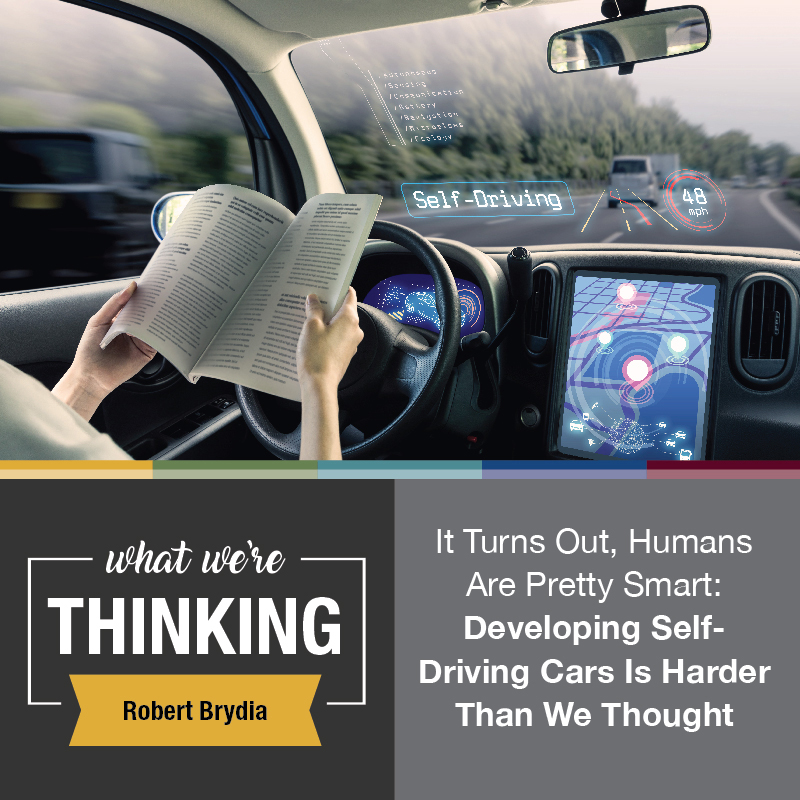Self-driving cars. We’ve been promised for years they were “coming soon.” Most estimates a decade ago thought self-driving cars would be commonplace by now. Yet, here we are in 2020, and self-driving cars — what the industry calls autonomous vehicles (AVs) — still largely exist only in science fiction. So much for riding to Grandma’s house and watching Netflix while our car does the driving for us.
So, what happened?
What We’ve Learned
Driving is harder than we thought, and even harder to teach to a machine. It’s a complex task that involves more than merely “seeing” and “reacting” to what happens on the road. The most advanced cars today are only now starting to recognize road signs and traffic lights. As reported in various media outlets in 2019, Ford President and CEO Jim Hackett acknowledged the company “overestimated the arrival of autonomous vehicles” by underestimating driving’s complexity. They weren’t alone. Some companies have concluded that AVs will never match the human brain’s ability to simultaneously juggle multiple driving tasks, react appropriately, and make correct decisions.
When driving, the brain makes judgments and assesses probabilities (for example, accommodating a bicyclist trying to beat us through the intersection). In a self-driving car, every aspect of that thought process (conscious or unconscious) must be programmed to ensure safety.
That. Is. Challenging.
While today’s computers are incredibly fast and powerful, they don’t yet know how to think. Humans have their own issues with poor decision-making — driving under the influence; driving drowsy or distracted — but until AVs can match the human mind’s ability to reason, they will never match a human’s ability to adapt to changing circumstances.
Transportation companies are beginning to realize this. Starsky Robotics, an automated freight company, shuttered in 2020, noting their belief that driverless vehicles — without true artificial intelligence — aren’t practical. And, apart from the design and testing of AVs and their capabilities to a safe standard, there are numerous issues to work out:
- How to ensure consistent operations across local, state and federal jurisdictions;
- How to assign clear responsibility for at-fault crashes (owner or manufacturer?);
- How to define (and enforce) traffic laws.
These are just a few of the questions needing answers before self-driving cars take over our roadways.
Where We’re Headed
Like a self-driving car adjusting to roadway conditions, the AV industry is adapting to circumstances. While companies continue to advance how “smart” driverless cars can be, autonomy innovations are evolving in other areas, too. Numerous efforts now focus on creating automated services that reliably — and safely — deliver goods. Still in development, Amazon’s Prime Air delivery service promises delivery by drone within 30 minutes of an online order — remember when that only applied to your local pizza shop? And speaking of pizza, other essential businesses — Domino’s Pizza, Kroger’s, CVS Pharmacies, to name a few — are also testing autonomous delivery services. And now’s the time to catapult those efforts forward. “People-less” delivery services help protect the elderly and individuals with underlying health conditions, populations most vulnerable to viruses like COVID-19, by reducing personal contact.
Despite current restrictions on movements and social interactions — some of which will persist into the foreseeable future — the COVID-19 pandemic provides opportunities (thanks to less traffic) for testing AV innovations on the road and in the air. Companies delivering goods via roadways are experimenting with “last mile” applications, which focus on the final step in the delivery process made at reduced speeds (think: delivering goods ordered online). In fact, Nuro, a market leader in robotic delivery services, is in trials in Houston, Texas. The company’s typical vehicle design is absent such features as a windshield, steering wheel, mirrors or even space for a driver.
Will these approaches succeed with their focus on carrying goods rather than people? Will we ever be able to relax in the back seat with a movie while a “smart car” drives us to Grandma’s? The verdict is still out. But how we approach developing autonomous transportation is changing — for the better — with increased emphasis on shorter trips and specific trip purposes, like local deliveries. The AV industry is actively engaging in multiple trials with different types of driverless vehicles. As a result, our overall understanding of AV potential is increasing.
So, what happened to that self-driving car? We learned how difficult it is to teach computers how to learn (and think) like a human. Guided by human minds, AV technology continues to evolve, just a little slower than we’d hoped. To maximize safety, that’s not a bad thing. Slow and steady wins the race.
Bob Brydia is a Senior Research Scientist with the Texas A&M Transportation Institute.
This article was originally published in ENO Center for Transportation Newsletter, July 31, 2020.
